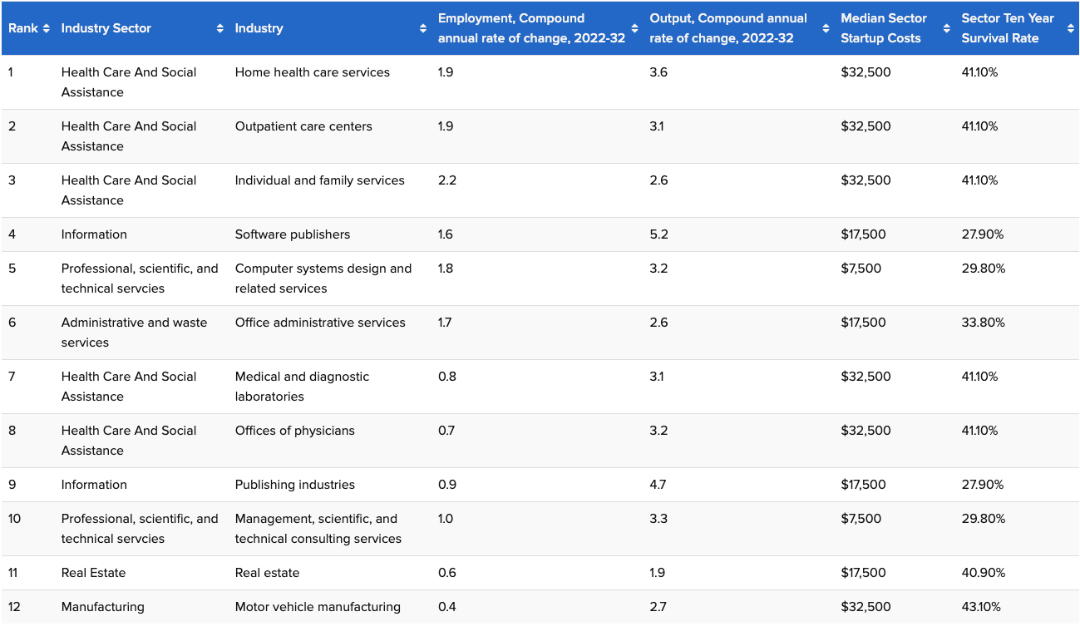
The 10 best industries to start a business in 2023
The 10 best industries to start a business in 2023
With 10 million new small businesses opening their doors in the U.S. in 2021-2022—the highest years on record—a new study reveals the top industries for starting a business.
As the U.S. experiences this small business boom, Lendio analyzed which industries are most likely to grow and succeed in the next decade, helping to answer the question: What industry should new entrepreneurs explore?
The study analyzed four metrics to determine the best industry to start a business, gauging the growth potential, ease of getting started, and longevity of the opportunity. Specifically, the study explored analysis on employment projections, production rate, 10-year survival rate by industry sector, and overall startup costs.
Key findings include:
- Healthcare opportunities remain hot. Five of the top industries that made the list are within the healthcare sector. Real estate, software publishing, office administration, print publishing, and manufacturing also made the cut.
- Agriculture and manufacturing have the best survival rates. Commodities, healthcare, and real estate rounded out the list with the highest survival rates compared to others.
Professional, scientific, and technical services come in at the lowest cost of entry. Not far behind are construction and agriculture, clocking in with the lowest cost to start or acquire.

These are the top industries in which to start a business this year
1. Home healthcare services
With the percentage of Americans over the age of 65 projected to reach over 20% of the population by 2040, it's no surprise home healthcare is an industry with a big growth trajectory, expected to grow at an accelerated rate over the next 10 years. There are many factors that are driving this growth, including an increasing demand for medical services and home care benefits for Medicare recipients.
2. Outpatient care centers
Similar to home healthcare, an increase in the aging population is driving demand for outpatient care, which normally includes healthcare services that don't require hospital admittance, such as X-rays, bloodwork, and routine checkups. For the population in general, technological advancements in the medical industry are producing a faster and more accessible patient experience for all ages. Moreover, demand for more local outpatient facilities has grown significantly in the post-pandemic period.
3. Individual and family services
Welfare assistance for individuals and families is a growing necessity. The U.S. market was valued at $233.6 billion in 2022, and the global market is expected to reach $2 trillion by 2030, at a compound annual growth rate (CAGR) of 10.8%. According to the U.S. Department of Health & Human Services, nearly half of the U.S. population lives in what is called a "health professionals shortage area," with an estimated 8,326 mental health practitioners needed.
4. Software publishers
In today's tech-powered world, software and software as a service (SaaS) are in high demand, especially at the enterprise level. Businesses are continuously looking for ways to streamline data and processes, which often leads to high payouts for publishers and developers. And demand for software is only expected to grow in the coming years, with revenue forecasts for the software industry expected to reach more than $414 billion by 2028.
5. Computer systems design and related services
Staying on the tech train, these services help design, support, and update computer hardware and software for other businesses. Evolving applications of software and a need for robust technological systems in a number of industry sectors contribute to the forecasted growth of this industry, which is estimated to be around 26% over the next 10 years.
6. Office administrative services
Any business owner can attest to the need to—and importance of—effectively running day-to-day operations. Tasks such as bookkeeping, hiring, and logistics, to name a few, are often immediate needs. It's expected that this industry will grow up to 10% year over year in 2023, with continued growth forecasted in the years beyond. As businesses expand and tap into new markets, having the right service provider for everyday tasks becomes a necessity, as advanced technology and interconnectivity across the globe lead the charge.
7. Medical and diagnostic laboratories
The U.S. medical and diagnostic laboratory services market is increasingly competitive among large and small providers. People need to know if they're healthy, and these facilities provide the necessary analyses of bodily fluids, genetic testing, and more for healthcare professionals to determine this. Rising rates of chronic illnesses, such as diabetes, cancer, and heart disease, are increasing demand in this industry. Industry revenue in the U.S. reached up to $71 billion in 2022 and is expected to grow to $141 billion by 2030.
8. Physician offices
The height of the pandemic exposed many points of weakness in the medical industry, including a shortage of physicians, nurses, staff, and equipment to handle the sudden influx of patients. Looking towards the future here, improved accessibility and a greater influx of in-person visits will drive an explosion in demand for more private practitioners, such as family medicine, internal medicine, and pediatrics.
9. Publishing industries
Reading is power, and increasing numbers of consumers like to read on the go, making digital print a growing medium. But physical print still remains an important part of the industry and the preferred outlet for readers. Textbooks also continue to create consistent growth for the printed word. However, transitioning to digital media, at least partly, has expanded revenue streams for publishers. Audiobooks in particular have increased their share of the U.S. book market over the past 10 years, reaching $1.8 billion in 2022, making it the fastest-growing segment within the industry.
10. Management, scientific, and technical consulting services
Running a business can get complicated, so across different sources, companies turn to the experts more often than not. From improving processes to lowering maintenance and operational costs, these providers help drive efficiency and develop strategies. The market value was valued at $316.6 billion in 2021, and that is expected to more than double by 2031, to $814.6 billion.
Runners up
1. Real estate
The current housing market is muddied with rising interest rates. But it's beginning to rebound, forecasted to grow at a CAGR of 4.7% from 2023 to 2028. While this industry encompasses both residential and commercial real estate, residential real estate accounts for the largest share of revenue in the United States, with a market volume projected at around $88.91 trillion for 2023. Although this industry is highly competitive, it's relatively easy to break into—required courses and certifications take around four to six months, on average, to complete. However, reaching high earnings will take a lot of hard work and dedication.
2. Motor vehicle manufacturing
Even though the automotive industry was one of the most affected by the pandemic, the lack of sales ultimately led to an increase in inventory. More cars means more sales opportunities, so the market is expected to go up and to the right. That—coupled with advances in technology, rapid urbanization, and a push toward electric vehicles—will lead to greater opportunities for revenue generation.
Methodology
We used publicly available data from a variety of federal government sources to identify the best industry in which to start a business in 2023. Our examination included:
- Projected growth in output and employment by industry from 2022 to 2032. Selected industries must have a positive projected growth in output. (Bureau of Labor Statistics)
- Ten-year survival rates of businesses starting in 2012. (Bureau of Labor Statistics)
- Amount spent to start or acquire a business excluding costs of $1 million+ Census.gov
Final thoughts
Your chosen industry can have an effect on your day-to-day operations, revenue projections, and timelines, as well as growth over time. As you choose your business venture, consider crucial aspects of running a business, such as overall production costs, location, and consumer demand.
Regardless of the industry you're in, a business owner faces a unique set of challenges. If you work through these with a solid plan in place and the right amount of capital to give you a financial lifeline, you'll be in a better position to achieve long-term success.
This story was produced by Lendio and reviewed and distributed by Stacker Media.



